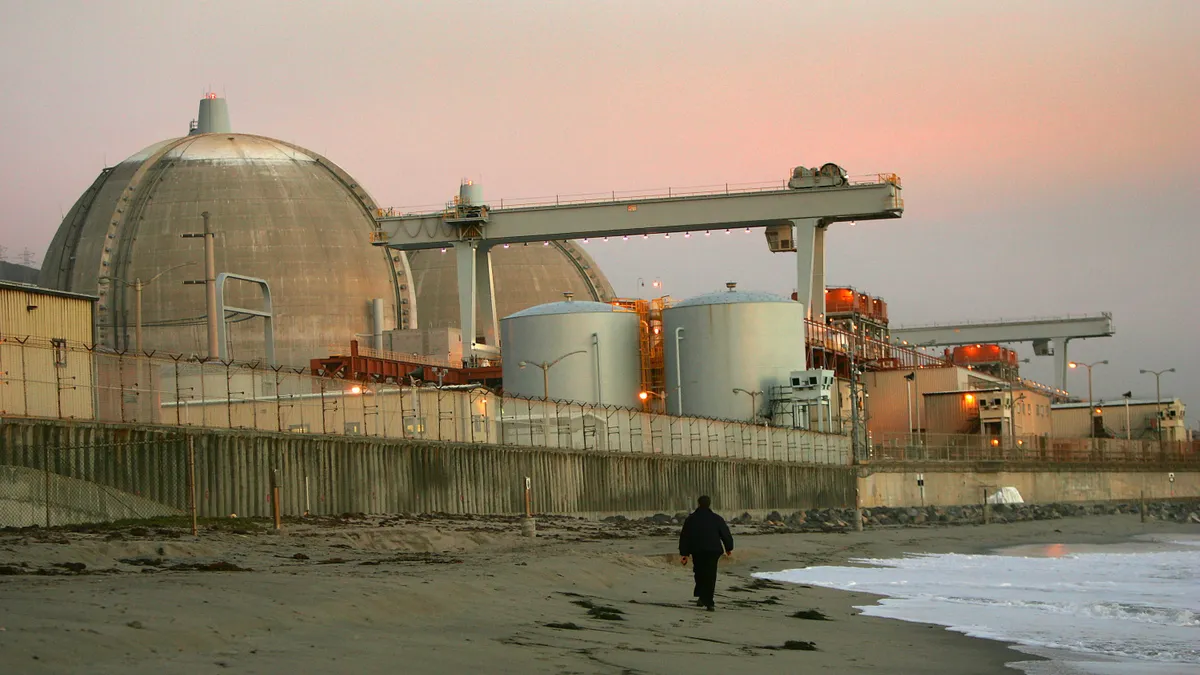Dive Brief:
- California could reduce its power sector emissions by more than 10% from 2017 levels, save $2.6 billion in power system costs and improve system reliability by delaying the retirement of Pacific Gas & Electric’s (PG&E) Diablo Canyon, its last nuclear plant, to 2035, according to a new report from experts at Stanford University and the Massachusetts Institute of Technology.
- Regulators in 2018 approved a settlement that would have the nuclear power plant shut down completely by 2025, when the federal license for its second unit expires. The Diablo Canyon facility provides 8% of in-state electricity and 15% of California’s carbon-free electricity, according to the report.
- PG&E is aware of the study, and its focus remains on safely and reliably operating the plant until the end of its licenses, which expire in 2024 and 2025, spokesperson Suzanne Hosn said in a statement. “The state has made clear its position on nuclear energy, and the plan to retire Diablo Canyon Power Plant has been approved by the California Public Utilities Commission and the state legislature,” Hosn added.
Dive Insight:
The California Public Utilities Commission (CPUC) in 2018 approved the settlement to shut down Diablo Canyon. However, the report noted that several developments have occurred since then that prompted the study team to take another look at the value of the 2,240 MW nuclear facility: In 2018, California committed to supplying all its electricity from zero-carbon sources and achieve climate neutrality by 2045. Two years later, the state experienced blackouts in the midst of a record-breaking heatwave.
The study found that if California operated Diablo Canyon through 2045 and beyond, it could save up to $21 billion in power system costs as well as 90,000 acres of land that would otherwise be used for energy production. It also determined that Diablo Canyon could be connected to a hydrogen plant to produce hydrogen at 50% less cost than that produced by solar and wind power. In addition, the plant could be used as a power source for desalination, it noted, providing the state with more fresh water supplies. And operating Diablo Canyon as a “polygeneration facility” — including the production of electricity, desalinated water and clean hydrogen — could increase the value of the plant by nearly 50%, according to the report.
The report acknowledged that there are many obstacles to achieving these goals, including reinitiating the process to relicense the facility at the federal level, getting approvals to construct hydrogen electrolysis facilities and desalination plants, and working with all the stakeholders who were part of the original settlement to shutter the nuclear plant.
However, the authors wrote, “the conclusions of this report present sufficient grounds for further study and debate by setting forth a prima facie case for extending the operations of the Diablo Canyon nuclear plant.”
Nuclear plants that have already been built present a very good option for dispatchable power in a high-renewables scenario, according to Steven Chu, Stanford professor and former U.S. Secretary of Energy. “The capex has been invested and in particular with Diablo Canyon, a lot of the upgrades were made in anticipation [of] applying for a 20-year extension,” of the plant, he said during a webinar on Monday.
Chu also pointed to the experience of other countries, like Japan and Germany, that turned off nuclear power and then saw an increase in fossil fuel plants and carbon emissions.
However, Mark Specht, a senior energy analyst with the Union of Concerned Scientists, said he is skeptical of some of the conclusions of the analysis, including the projected near-term reductions in greenhouse gas emissions and near-term grid reliability benefits from keeping Diablo Canyon online. If the facility were to stay online, power providers in California could procure a lot less renewables and energy storage, he said.
Specht acknowledged that real world factors have changed since the Diablo Canyon settlement was approved in 2018, which could potentially change the outcome of the financial analysis around running the plant.
At the same time, “I’m not sure it’s worth opening up that can of worms again,” Specht said, noting that the settlement to close the plant came from a multi-year process with many stakeholders.
“There are still real issues with nuclear waste… there are seismic safety concerns with Diablo Canyon, and just the process of relicensing this nuclear power plant,” could present challenges, Specht added.














